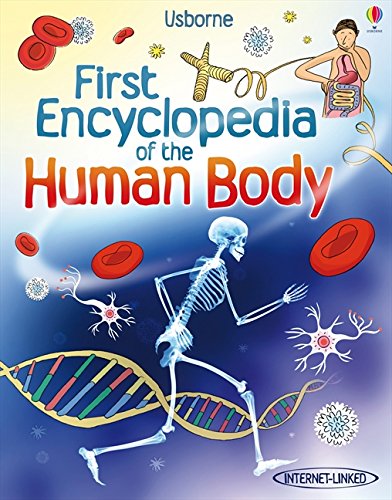-
Usborne CHILDREN'S ENCYCLOPEDIA New Edition SoftCover w QR & Internet Links
Felicity Brooks
Paperback (Usborne Books, Jan. 1, 2014)Jam-packed with information, photographs, charts and maps for additional study and research. Links to over 150 recommended websites through the Usborne Quicklinks Website Downloadable quizzes, word searches and activity sheets Over 1,500 amazing photographs, illustrations and diagrams Up-to-date information on hundreds of topics Lots of free, downloadable pictures Simple, safe activities and experiments Maps of the world and flags of every country Facts and records Over 150 QR codes allow readers to access carefully selected websites, downloadable pictures and quizzes - straight to a mobile phone or tablet. An additional 750 internet links lead to a hand-picked selection of the best websites available on a desktop computer.
-
First Encyclopedia of Science
Rachel Firth, Felicity Brooks, Anna Claybourne
Hardcover (Usborne Books, Feb. 1, 2011)This is an excellent reference for school projects. All major topics are explored. It includes free downloadable pictures. Why do things float? What happens to the food you eat? Find out the answers to these and many more questions in this lively book that introduces young readers to the wonders of science. It comes with simple text, amazing photographs and illustrations, fun science activities and exciting recommended Web sites.
-
Usborne First Encyclopedia of Science
Rachel Firth, Felicity Brooks, Anna Claybourne, David Hancock
Paperback (EDC, Aug. 16, 2011)These and hundreds of other questions about science are answered in this charming book, Simple, easy-to-read text and lively, detailed illustrations introduce the basic concepts of science to young readers. W
W
-
First Encyclopedia of the Human Body
Fiona Chandler, David Hancock, John Woodcock
Hardcover (Usborne Books, April 1, 2011)This is a fantastic new edition of this bright and lively encyclopedia, introducing young readers to the wonders of the human body. Filled with information on the brain, respiration, circulation and the senses, this book answers such questions as 'Where does your food go?' 'How many bones are there in your body?' and 'What are eyelashes for?'. Simple text, amazing photographs, detailed illustrations and a selection of exciting recommended websites make the subject easy to understand.
-
First Encyclopedia of History
Fiona Chandler, David Hancock
Library Binding (San Val, )None F
F
-
First Encyclopedia of History
Fiona Chandler, David Hancock
Paperback (Usborne Pub Ltd, June 1, 2003)With an easy-to-read text, this book provides an ideal introduction to history for young children. Intended for school projects it offers links to Internet sites which explore in more detail the topics covered. F
F
-
Encyclopedia of Coloured Pencil Techniques, The: A complete step-by-step directory of key techniques, plus an inspirational gallery showing how artists use them
Judy Martin
Paperback (Search Press, Nov. 21, 2016)An indispensable guide for anyone keen to learn coloured pencil techniques, or for the experienced artist who would like to build on their existing skills. Filled with information on the basic characteristics and colour ranges of the main kinds of coloured pencil, and step-by-step visual demonstrations of key techniques from blending, blocking in and burning to sgraffito, stippling and impressing. The reader will not only discover how professional artists use imaginative and dynamic styles to interpret a wide range of subjects, but they will also be inspired by the 150-plus full-colour illustrations to create brilliant artworks of their own. Z
Z
-
First Encyclopedia of Animals
Paul Dowswell, Judy Tatchell, Fiona Johnson
Hardcover (Usborne Books, May 1, 2011)This is a fantastic new edition of this bright and lively encyclopedia, introducing young readers to the wonders of the animal world. Filled with information on mammals, birds, reptiles, creepy-crawlies and waterlife, this book answers such questions as 'Which animal has a tongue as long as its body?'; 'How does a whale breath?'; 'How does a snake see in the dark?'; and, 'Why do zebras have stripes?'. Simple text, amazing photographs, detailed illustrations and a selection of exciting recommended websites make the subject easy to understand.
-
First Encyclopedia of the Human Body
Fiona Chandler, David Hancock, John Woodcock
Paperback (EDC Publishing/Usborne Books, June 1, 2011)Amazing photographs and illustrations with lively text to explain the amazing human body. 64 pages. P
P
-
Farm Animals
Teora USA
Paperback (Teora USA Llc, June 15, 2007)A first encyclopedia with stickers, answers your child's questions about farm animals, while providing hours of fun! M
M
-
Encyclopedia of Drawing Techniques, The: The step-by-step illustrated guide to over 50 techniques
Hazel Harrison
Paperback (Search Press, Dec. 22, 2014)Detailed photographic sequences explore pencil, charcoal, pen and technical pen techniques, including shading, building up, blending, hatching, highlighting, stippling and more. Coloured pencils, chalks, pastels, and pen and ink are also covered with inspirational pictures across a full range of subject matter, including landscapes, buildings, figures, animals, flowers and still life. Techniques are discussed in detail including layering, feathering, burnishing, linear marks and pointillism. The use of paint and brushes is less obvious in a book on drawing, but there are some techniques in which the brush is used to create a line, or to infill a linear shape. These techniques are discussed as well with Gallery examples shown throughout to act as inspiration for the practising artist. Sequences on mixed media, keeping a sketchbook and digital drawing are included too, making this book an invaluable addition to any artists book shelves. W
W
-
First Encyclopedia of Dinosaurs and Prehistoric Life
Sam Taplin, David Hancock, Keith Newell
Hardcover (Usborne Books, Feb. 1, 2011)This is a thrilling introduction to prehistoric times. It has fabulous illustrations and clear, simple text. It is an ideal reference book for school projects. It features a glossary, index and facts and records. It presents internet-links to amazing websites. What was the biggest dinosaur? When was the ice age? Why did the dinosaurs die out? Find out in this lavish and lively book. Simple text, beautiful illustrations, stunning photographs of dinosaur models and links to exciting recommended websites introduce young readers to the wonder of the prehistoric world. Q
Q